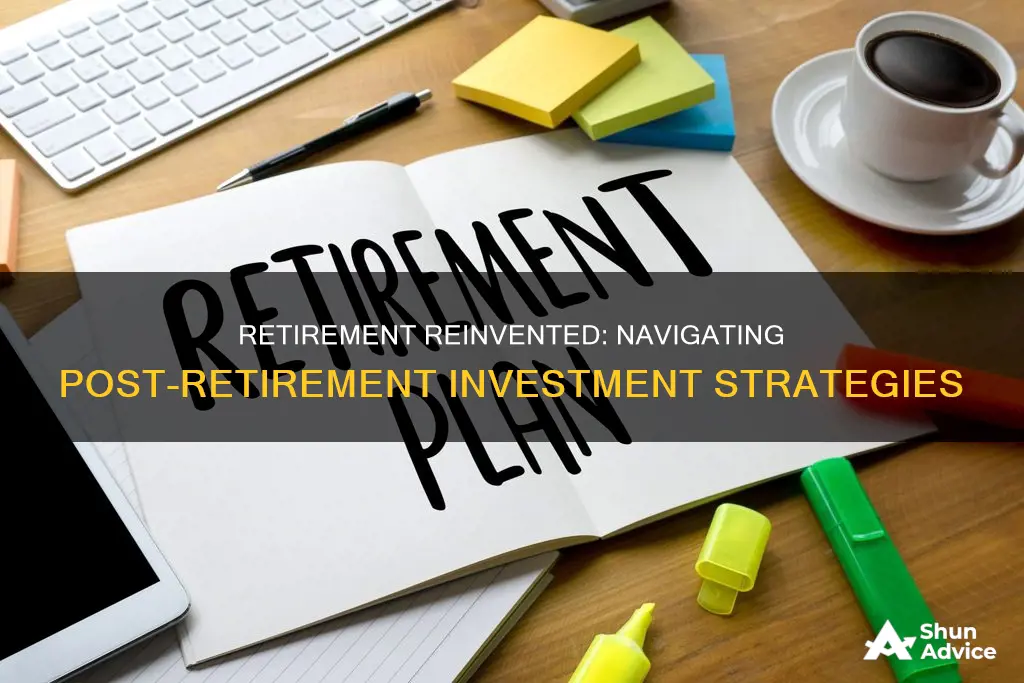
Investing after retirement is an important consideration for retirees. It's wise to review and adjust your retirement investments to help meet your goals and protect your income streams. There are various investment options, strategies and approaches to consider, including mutual funds, bond funds, stocks, annuities, real estate, and certificates of deposit.
The right strategy will depend on your unique circumstances, such as your risk tolerance, retirement goals, and capital on hand. It's crucial to find a balance between riskier assets that deliver high returns and safe, reliable assets that preserve your portfolio.
Additionally, understanding the tax implications of different investments and seeking advice from a financial planner or advisor can also help enhance your retirement security and investment income potential.
| Characteristics | Values |
|---|---|
| Investment options | Mutual funds, bond funds, stocks, annuities, real estate, certificates of deposit, cash, income-producing equities |
| Investment goals | Capital preservation, generating additional income |
| Investment strategies | Diversification, tax efficiency, income protection, sequence-of-return risk mitigation, cash reserves, financial planning, equities |
| Risk factors | Risk tolerance, market volatility, investment time horizon, interest rates, inflation, liquidity, tax penalties |
What You'll Learn

Calculate your retirement expenses and income
To calculate your retirement expenses and income, you need to consider several factors, including your current income, savings, and investments, as well as your expected expenses and income during retirement. Here's a step-by-step guide to help you through the process:
Determine your current financial situation:
Start by calculating your pre-tax annual income, including any business earnings and regular sources of income. Then, assess your current retirement savings by adding up the balances of all your retirement accounts, such as 401(k) plans, Individual Retirement Accounts (IRAs), and other savings earmarked for retirement. This will give you a clear picture of your current financial standing.
Estimate your retirement expenses:
Think about the lifestyle you want to maintain during retirement. Consider your desired travel plans, dining out, entertainment, and any potential relocation. By outlining these expenses, you can estimate your monthly or annual retirement expenses. Remember to account for inflation, which will impact the cost of goods and services over time.
Calculate your expected retirement income:
In addition to your savings and investments, there are other sources of retirement income to consider. Social Security is a common source for many retirees. You can use online calculators to estimate your Social Security income based on your work history and income. Additionally, if you're married, you may be eligible for increased Social Security benefits. Other sources of retirement income could include pensions or rental income.
Compare expenses and income:
Once you have estimated your retirement expenses and income, it's time to compare the two. Calculate the gap between your essential expenses and guaranteed income. This will help you identify any potential shortfall or surplus in your retirement finances. If there is a gap, you can start thinking about ways to address it, such as adjusting your savings rate or considering additional income streams.
Use online tools and calculators:
Take advantage of online retirement calculators, which can help you estimate your retirement needs and provide a more detailed breakdown of your finances. These tools consider factors such as your age, income, savings, and expected rate of return on investments to give you a clearer picture of your retirement expenses and income. They can also help you identify any adjustments needed to meet your retirement goals.
Remember, it's important to start planning for retirement as early as possible. By regularly reviewing and adjusting your retirement calculations, you can make informed decisions about your finances and work towards a comfortable retirement.
Savings Strategies: Where to Invest
You may want to see also

Diversify your portfolio
Diversifying your portfolio is a crucial aspect of investing after retirement. Diversification helps to limit the impact of risks and negative performance of any single asset. Here are some key considerations for diversifying your portfolio:
Diversification Strategies:
- Different Asset Classes: Diversification involves investing in various asset classes such as stocks, bonds, cash, and alternative investments. Stocks, particularly growth stocks, are ideal for younger investors due to their long-term growth potential. Bonds, including government and corporate bonds, are more conservative investments that offer regular income and lower risk. Alternative investments like precious metals, derivatives, and real estate can also be part of your portfolio to reduce volatility and provide returns during idle periods for traditional assets.
- Geographic and Sector Diversification: Within your stock and bond holdings, ensure you diversify across different geographic regions, sectors, and industries. This helps to further mitigate risks associated with specific regions or sectors.
- Mix of Growth and Income Investments: Depending on your age and risk tolerance, balance your portfolio between growth-oriented investments (e.g., stocks) and income-generating investments (e.g., bonds, annuities). As you approach retirement, gradually shift towards more income-focused investments to preserve capital and generate stable returns.
- Correlation and Non-Correlation: Understand the correlation between different investments. Aim for non-correlation or negative correlation, where the performance of one investment does not impact the other. For example, stocks and bonds often have a negative correlation, providing a diversification benefit.
- Risk Tolerance and Time Horizon: Your risk tolerance and time horizon will change as you age. Younger investors can tolerate more risk and focus on growth, while older investors may seek capital preservation and lower-risk investments.
- Robo-Advisors and Financial Planners: Consider using robo-advisors or financial planners to help manage your portfolio. Robo-advisors use algorithms to allocate and manage your investments, while financial planners provide personalised advice and strategies.
Best Practices for Diversification:
- Review and Adjust: Regularly review and adjust your portfolio to ensure it aligns with your retirement goals and risk tolerance. Market uncertainty, life events, and cost-of-living changes can impact your strategy.
- Avoid Over-Concentration: Avoid having a significant portion of your retirement savings in a single investment, such as company stock. Diversification helps protect your portfolio from being drastically affected by the underperformance of a single asset.
- Emergency and Short-Term Funds: Maintain adequate emergency savings and short-term funds to cover unexpected expenses and short-term goals. This helps you avoid the need to sell investments at a loss during market downturns.
- Tax Efficiency: Consider the tax implications of your investments. Utilise tax-deferred accounts, such as IRAs, and taxable accounts strategically to optimise tax efficiency.
- Education and Research: Educate yourself about different investment options and their risks and returns. Stay informed about market trends and seek advice from reliable sources to make informed decisions.
Is it wise to invest now?
You may want to see also

Tax-efficiency strategies
Taxes can take a significant chunk out of your investments, so tax-efficient investing is a good strategy to minimise your tax burden and maximise your bottom line. Here are some tax-efficiency strategies to consider:
- Live in a Tax-Friendly State: Consider moving to a state with no income taxes or low taxes on Social Security benefits and retirement income. Eight states in the US have no income taxes: Alaska, Florida, Nevada, South Dakota, Tennessee, Texas, Washington, and Wyoming.
- Reassess Your Investments: Municipal bonds are tax-efficient as the interest income is usually exempt from federal income tax. Qualified dividends from publicly traded US corporations are also taxed at more favourable rates than ordinary income. You can also use capital losses to offset capital gains, reducing your tax liability.
- Avoid or Postpone Required Minimum Distributions (RMDs): If you are 73 or older, you can avoid paying taxes on RMDs from your traditional IRA by transferring the funds to a charity. Alternatively, you can invest in a qualified longevity annuity contract (QLAC) to postpone RMDs and ensure a steady income stream later in retirement.
- Be Strategic About Social Security Benefits: Delaying the receipt of Social Security benefits until age 70 can increase your monthly benefits and reduce your taxes. Withdrawals from a Roth IRA are also tax-free and do not impact the taxation of Social Security benefits.
- Tax-Advantaged Accounts: Utilise tax-advantaged accounts such as IRAs and 401(k)s, which provide tax breaks. While these accounts have annual contribution limits, they can help maximise tax efficiency by holding investments that lose more of their returns to taxes.
- Taxable Accounts: Consider using taxable accounts, such as brokerage accounts, for investments that lose less earnings to taxes. These accounts offer more flexibility than tax-advantaged accounts and the returns are taxed based on how long the asset is held.
- Proportional Withdrawals: Instead of withdrawing from one account at a time, consider taking proportional withdrawals from each account based on its percentage of your overall savings. This can help spread out taxable income and potentially reduce taxes on Social Security benefits and Medicare premiums.
- Leverage Roth IRAs: Fund a Roth IRA with after-tax dollars to enjoy tax-free growth and withdrawals in retirement. Roth IRAs are also not subject to RMDs, giving you more flexibility.
- Spousal IRA: If one spouse is not working, consider opening a spousal IRA to increase your contributions and lower your taxes. The non-working spouse can contribute to their own IRA, taking advantage of their partner's income.
- Tax-Exempt Municipal Bonds: Invest in municipal bonds issued in your state to avoid state and local taxes. These can provide tax-free income, especially if you live in a state with no income tax.
- Permanent Life Insurance: The right life insurance policy can provide tax benefits. Permanent life insurance, such as variable universal life, can build up cash value on a tax-deferred basis, and beneficiaries receive death benefit payouts tax-free.
- Tax-Efficient Charitable Giving: Consider charitable remainder trusts, charitable gift annuities, or qualified charitable distributions (QCDs) to satisfy RMDs and receive tax benefits while supporting charities.
LetGo: Why Venture Capitalist Investments?
You may want to see also

Annuities for income protection
Annuities are a form of insurance contract issued by financial institutions that can be used to guarantee a steady income stream during retirement. They are a popular option for retirees who want to ensure they have a stable and secure income to rely on. Annuities can be purchased by making monthly premium payments or a lump-sum payment, and in return, the annuitant receives regular payments for a fixed period or for the rest of their life. This can provide peace of mind and protect against the risk of outliving one's savings.
There are different types of annuities available, including fixed, variable, and indexed annuities. Fixed annuities provide a guaranteed minimum rate of return over a specific period or the annuitant's lifetime. Variable annuities offer the potential for higher returns by investing in sub-accounts similar to mutual funds but come with more risk. Indexed annuities, such as the S&P 500, offer a return based on the performance of an equity index.
Annuities can be immediate or deferred. Immediate annuities are often purchased by people who have received a large sum of money and want to exchange it for future cash flows. Deferred annuities allow annuitants to specify an age when they would like to start receiving payments.
Annuities offer several benefits, including guaranteed income, tax-deferred growth, and the ability to customise the contract with riders. However, they also have drawbacks, such as high expenses, complex contractual language, and the possibility of an insurer defaulting. It is important for individuals to carefully consider their financial goals and consult a financial advisor before investing in annuities.
Adani Power: Invest Now?
You may want to see also

Hold cash reserves
Holding cash reserves is an important part of investing after retirement. It can be tricky for retirees to know how much cash to keep on hand, but it's crucial to have enough to cover unexpected expenses and avoid selling investments at a loss during market downturns. Here are some key considerations for retirees when it comes to holding cash reserves:
Emergency Funds and Short-Term Goals
It is generally recommended to have an emergency fund that covers three to six months' worth of living expenses. However, some experts suggest that retirees should aim for a larger reserve of six to twelve months, or even up to three years' worth of expenses. This buffer can help retirees avoid dipping into their retirement savings prematurely or selling investments at a loss during market downturns. It is also important to keep this emergency fund in a safe and easily accessible place, such as an FDIC-insured bank account, to ensure it is readily available when needed.
Market Downturns and Investment Strategies
Holding cash reserves can provide safety during stock market downturns. If you have a substantial amount of your retirement income coming from investment portfolios, having cash reserves can prevent you from being forced to sell your investments at a loss to cover living expenses. It allows you to ride out the market volatility and sell when the price is higher. Additionally, retirees should consider their risk tolerance and adjust their investment portfolios accordingly. As you approach retirement, it is generally advisable to increase the percentage of lower-risk investments, such as bonds, in your portfolio.
Inflation and Growth
While holding cash reserves is important, it is also essential to consider the impact of inflation. Holding too much cash can cause your purchasing power to decrease over time. Therefore, it is crucial to strike a balance between having enough cash reserves and investing in growth opportunities to outpace inflation. Diversification is key—spreading your investments across different asset classes, such as stocks, bonds, and cash equivalents, can help maximise returns and manage risk.
Personal Circumstances and Risk Tolerance
The amount of cash reserves you need depends on various factors, including your age, total savings, lifestyle plans, monthly expenses, and risk tolerance. If you have a pension or Social Security benefits covering your living expenses, you may not need as large of a cash reserve. On the other hand, if your retirement income relies solely on withdrawals from savings and investment accounts, a larger cash reserve is advisable. Your capacity and willingness to take risks also play a role in determining the size of your cash reserve.
Merck: A Worthy Investment?
You may want to see also
Frequently asked questions
There are several investment options for retirees, including stocks, bonds, mutual funds, real estate rentals, and certificates of deposit. Each option has its own risks and benefits, so it's important to consider your financial goals and risk tolerance before deciding.
A balanced portfolio typically includes a mix of stocks, bonds, and cash investments. The specific allocation will depend on your timeline and risk tolerance, but a common guideline is that the percentage of stocks in your portfolio should equal 100 minus your age. For example, if you're 65, around 35% of your portfolio should be in stocks.
A financial advisor can help you optimize your investment strategy and ensure you're making the right asset choices for your needs. They can provide expert guidance on investment strategies, retirement planning, and tax implications.
When investing in stocks during retirement, it's generally recommended to take a more conservative approach. Look for defensive stocks that offer products and services seen as essential, such as utilities, telecommunications, consumer staples, and healthcare. You may also want to consider dividend stocks, which provide a percentage of profits paid out to shareholders.







